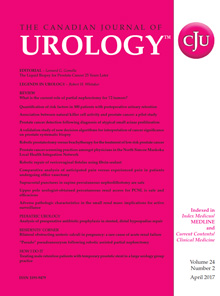 Indexed in Index Medicus and Medline
Indexed in Index Medicus and Medline
HOW I DO IT
-
How I Do It: Transcutaneous tibial nerve stimulation TENSI+ system
Cornu Jean-Nicolas, Hashim Hashim, Van Der Aa Frank, De Nunzio Cosimo, Perez Garcia Valentina, Ferreira Roseanne, Elterman S. Dean Department of Urology, Charles Nicolle University Hospital, University of Rouen, Rouen, France
Overactive bladder (OAB) is a common condition that significantly impacts the quality of life (QoL), well-being and daily functioning for both men and women. Among various treatments, peripheral tibial nerve stimulation (PTNS) emerges as an effective third-line treatment for OAB symptoms, with options for either a percutaneous approach (P-PTNS) or by transcutaneous delivery (T-PTNS). Recent studies have shown negligible differences between P-PTNS and T-PTNS efficacy in alleviating urinary urgency and frequency and QoL improvement and, overall no difference in efficacy over antimuscarinic regimens. The TENSI+ system offers a cutting-edge transcutaneous approach, allowing patients to self-administer treatment conveniently at home with electrical stimulation delivery through surface electrodes. It stands out for its ease of preparation, tolerability, and high levels of patient satisfaction. Prospective multicentric data highlights TENSI+ to be an effective and safe treatment for lower urinary tract symptoms with high treatment adherence at 3 months. This paper aims to familiarize readers with the TENSI+ system, current studies, device assembly, operation, and treatment recommendations.
Keywords: OAB, PTNS, T-PTNS, TENSI+,
Dec 2023 (Vol. 30, Issue 6 , Page 11756)PDF (758.1KB)Free -
How I Do It: ERAS protocol featuring erector spinae plane block for percutaneous nephrolithotomy
Zhang Bertie, Ochuba J. Arinze, Mullen R. Gregory, Rai Arun, Aro Tareq, Hoenig M. David, Okeke Zeph, Winoker S. Jared The Smith Institute for Urology at Lenox Hill, Zucker School of Medicine at Hofstra/Northwell Health, New York, New York, USA
Percutaneous nephrolithotomy (PCNL) is the gold-standard treatment for large and complex renal stones. Though associated with higher stone-free rates compared to other minimally invasive stone procedures, this comes at the expense of increased morbidity including postoperative pain and discomfort. We describe our enhanced recovery after surgery (ERAS) protocol for PCNL with emphasis on the use of erector spinae plane blocks to improve patient satisfaction and reduce postoperative opioid use and bother.
Keywords: regional anesthesia, PCNL, ERAS, multimodal pain control,
Aug 2023 (Vol. 30, Issue 4 , Page 11639)PDF (238.4KB)Free -
How I Do It: Maintenance avelumab for advanced urothelial carcinoma
Lalani A. Aly-Khan Department of Oncology, Juravinski Cancer Centre, McMaster University, Hamilton, Ontario, Canada
For more than four decades, platinum-based chemotherapy regimens have served as the established standard-of-care for advanced urothelial carcinoma (aUC). However, advancements in our understanding of cancer biology and tumor microenvironment have reshaped the therapeutic landscape and prognosis of this incurable disease. Immune checkpoint inhibitors (ICIs) that target programmed cell death 1 (PD-1) and programmed cell death ligand 1 (PD-L1) are firmly established tools in aUC management, leading to enhanced life span and improved quality of life for patients. In patients who achieved stable disease or better following platinum-based chemotherapy, maintenance therapy with the PD-L1 antibody avelumab significantly enhanced overall survival (OS) by approximately 7 months compared to best supportive care in the phase 3 JAVELIN Bladder 100 trial. As a result, avelumab received FDA approval in June 2020 as a maintenance therapy for aUC patients treated with first-line platinum-based chemotherapy. Therefore, aUC care plans should incorporate maintenance avelumab into standard first-line treatment regimens for these patients. The objective of this brief article is to provide insight into the utilization of avelumab, identify patients who may benefit from this treatment, and review the methodology, advantages, potential side effects and their management.
Keywords: bladder cancer, avelumab, advanced urothelial carcinoma, metastatic, immune checkpoint inhibitor,
Aug 2023 (Vol. 30, Issue 4 , Page 11633)PDF (170.9KB)Free -
How I Do It: Ureteroscopy and high-power holmium laser lithotripsy to treat renal stones
Higgins M. Andrew, Wolf J. Michael, Becker E. N. Russell, Ghani R. Khurshid Division of Endourology, Department of Urology, University of Michigan, Ann Arbor, Michigan, USA
In North America, ureteroscopy has become the most popular treatment modality for upper urinary tract urinary calculi. Herein we describe our technique for the treatment of renal stones with flexible ureteroscopy and high-power holmium laser lithotripsy. We discuss preoperative planning, intraoperative strategies, and laser settings for a high-frequency dusting technique with the goal to provide optimal patient outcomes.
Keywords: ureteroscopy, urolithiasis, laser lithotripsy, dusting, fragmentation,
Jun 2023 (Vol. 30, Issue 3 , Page 11574)PDF (1.1MB)Free -
How I Do It: Optilume BPH catheter system
Elterman S. Dean, Gao Bruce, Zorn C. Kevin, Bhojani Naeem, Te Alexis, Chughtai Bilal, Kaplan A. Steven Division of Urology, Department of Surgery, University of Toronto, Ontario, Canada
Benign prostatic hyperplasia (BPH) is a common and progressive disease affecting aging men which has a significant impact on quality of life. The Optilume BPH Catheter System (Optilume BPH) is a prostatic dilation system that combines balloon dilation with a localized transfer of paclitaxel to maintain long term patency. Optilume BPH can be deployed using standard rigid cystoscopy without general anesthesia in an office setting. Prospective data indicate that Optilume BPH has favorable functional and sexual patient outcomes. Readers will familiarize themselves with Optilume BPH, significant historical studies and the technique for deploying Optilume BPH.
Keywords: prostate, BPH, MIST, Optilume,
Jun 2023 (Vol. 30, Issue 3 , Page 11568)PDF (396.1KB)Free

